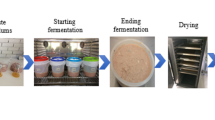Abstract
Extracellular lipase production by Staphylococcus epidermidis CMST Pi 2 isolated from the intestine of shrimp Penaeus indicus has been investigated in shake-flask experiment using different preparations of tuna-processing waste such as raw fish meat, defatted fish meat, alkali hydrolysate, and acid hydrolysate as nitrogen source. Among the tested tuna preparations, defatted fish meat supported the maximum lipase production, and 2.5% concentration of the same was found to be optimum for maximizing the lipase production. The effect of carbon sources on lipase production revealed that glucose aided the higher lipase production than any other tested carbon source and a concentration of 2% glucose registered as optimum to enhance the lipase production. The halotolerancy of S. epidermidis CMST Pi 2 for lipase production indicated that 4% of sodium chloride was optimum to yield maximum lipase. Among the surfactants tested, lipase production was high in Tween 20 added medium when compared to other surfactants, and its optimum concentration recorded was 0.8%. Partial characterization of crude enzyme revealed that pH 7 and 55 °C temperature were optimum for maximum lipase activity.






Similar content being viewed by others
References
Godtfredsen, S. E. (1990). Microbial lipases. In W. M. Fogarty & C. T. Kelly (Eds.), Microbial enzymes and biotechnology (pp. 255–273). Amsterdam: Elsevier.
Sharma, R., Chisti, Y., & Banerjee, U. C. (2001). Biotechnology Advances, 19, 627–662. doi:10.1016/S0734-9750(01)00086-6.
Ellouz, Y. T., Ghorbel, B., Souissi, N., Kammoun, S., & Nasri, M. (2003). World Journal of Microbiology & Biotechnology, 19, 41–45. doi:10.1023/A:1022549517421.
Raa, J., & Gilberg, A. (1982). CRC Critical Reviews in Food Science and Nutrition, 16, 383–419.
Dufosse, L., La Broise, D. D., & Guerard, F. (2001). Current Microbiology, 42, 32–38. doi:10.1007/s002840010174.
Musantra, A. (1992). Applied Microbiology and Biotechnology, 38, 61–66.
Gao, M. T., Hirata, M., Toorisaka, E., & Hano, T. (2006). Bioresource Technology, 97, 2414–2420.
Batista, I. (1999). European Journal of Food Research Technology, 210, 84–89. doi:10.1007/s002170050539.
A.O.A.C. (1980). Official methods of analysis (13th ed.). Washington, DC: Association of Official Agricultural Chemists.
Folch, J., Ees, M. I., & Slone Staneley, G. H. (1957). The Journal of Biological Chemistry, 226, 497–509.
Ghorbel, S., Soussi, N., Ellouz, Y. T., Duffosse, L., Guerard, F., & Nazri, M. (2005). World Journal of Microbiology & Biotechnology, 21, 33–38. doi:10.1007/s11274-004-1556-2.
Ellouz, Y. T., Bayoudh, A., Kammoun, S., Gharsallah, N., & Nasri, M. (2001). Bioresource Technology, 80, 40–51. doi:10.1016/S0960-8524(01)00057-8.
Souissi, N., Ellouz, Y. T., Bougatef, A., Blibech, M., & Nasri, M. (2008). Microbiological Research, 163, 473–480. doi:10.1016/j.micres.2006.07.013.
Bancerz, R., Ginalska, G., Fiedurek, J., & Gromada, A. (2005). Journal of Industrial Microbiology & Biotechnology, 32, 253–260. doi:10.1007/s10295-005-0235-0.
Dharmsthiti, S., & Kuhasuntisuk, B. (1998). Journal of Industrial Microbiology & Biotechnology, 21, 75–80. doi:10.1038/sj.jim.2900563.
Lin, E. S., & Ko, H. C. (2005). Enzyme and Microbial Technology, 37, 261–265. doi:10.1016/j.enzmictec.2005.03.012.
Abdul Rahman, R. N. Z. R., Baharum, S. N., Salleh, A. B., & Basri, M. (2006). Journal of Microbiology (Seoul, Korea), 44(6), 583–590.
Babu, J., Ramteke, P. W., & Pa Ashok, Kumar. (2006). Journal of General and Applied Microbiology, 52(6), 315–320. doi:10.2323/jgam.52.315.
Boutaiba, S., Bhatnagar, T., Hacene, H., Mitchell, D. A., & Baratti, J. C. (2006). Journal of Molecular Catalysis. B, Enzymatic, 41, 21–26. doi:10.1016/j.molcatb.2006.03.010.
Martin, S., Marquez, M. C., Sanchez-Porro, C., Mellado, E., Arahal, D. R., & Ventosa, A. (2003). International Journal of Systematic and Evolutionary Microbiology, 53, 1383–1387. doi:10.1099/ijs.0.02528-0.
Joshi, A. A., Kanekar, P. P., Kelkar, A. S., Sarnaik, S. S., Shouche, Y., & Wani, A. (2007). Journal of Basic Microbiology, 47(3), 213–221. doi:10.1002/jobm.200610223.
Alberto, D., Deive, F. J., Sanroman, A., & Longo, M. A. (2003). Journal of Chemical Technology and Biotechnology (Oxford, Oxfordshire), 78, 1166–1170. doi:10.1002/jctb.922.
Johri, B. N., Alurralde, J. D., & Klien, J. (1990). Applied Microbiology and Biotechnology, 33, 367–371. doi:10.1007/BF00176648.
Dharmsthiti, S., Pratuangdejkul, J., Theeragool, G., & Luchai, S. (1998). The Journal of General and Applied Microbiology, 44, 139–145. doi:10.2323/jgam.44.139.
Bancerz, R., & Ginalska, G. (2007). Journal of Industrial Microbiology & Biotechnology, 34(8), 553–560. doi:10.1007/s10295-007-0232-6.
Hoshino, T., Ishizaki, K., Sakamoto, T., Kumeta, H., Yumoto, I., Matsuyama, H., et al. (1997). Letters in Applied Microbiology, 25, 70–72. doi:10.1046/j.1472-765X.1997.00183.x.
Ginalska, G., Bancerz, R., & Korniłłowicz-Kowalska, T. (2004). Journal of Industrial Microbiology & Biotechnology, 31, 177–182. doi:10.1007/s10295-004-0134-9.
Falony, G., Armas, J. C., Dustet Mendoza, J. C., & Hernández, J. L. M. (2006). Food Technology and Biotechnology, 44(2), 235–240.
Prazeres, J. N. D., Bortollotti Cruz, J. A., & Pastore, G. M. (2006). Brazilian Journal of Microbiology, 37, 505–509. doi:10.1590/S1517-83822006000400019.
Author information
Authors and Affiliations
Corresponding author
Rights and permissions
About this article
Cite this article
Esakkiraj, P., Austin Jeba Dhas, G., Palavesam, A. et al. Media Preparation Using Tuna-Processing Wastes for Improved Lipase Production by Shrimp Gut Isolate Staphylococcus epidermidis CMST Pi 2. Appl Biochem Biotechnol 160, 1254–1265 (2010). https://doi.org/10.1007/s12010-009-8632-x
Received:
Accepted:
Published:
Issue Date:
DOI: https://doi.org/10.1007/s12010-009-8632-x




